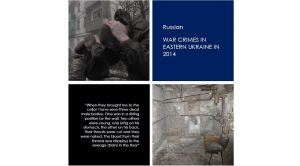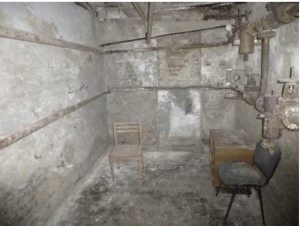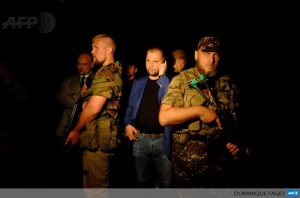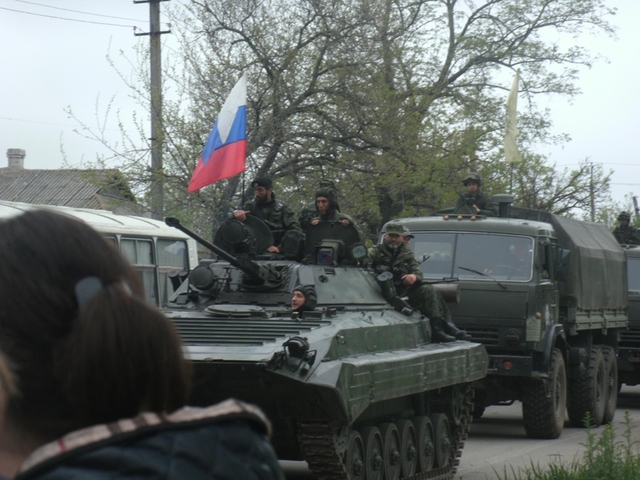A new 156-page investigative report identifies for the first time perpetrators of war crimes in Russia's war in East Ukraine. The extensive evidence presented will be submitted to the International Criminal Court in The Hague which has jurisdiction to prosecute individuals for international crimes of genocide, crimes against humanity and war crimes.
 The report entitled Russian War Crimes in Eastern Ukraine in 2014 is based on numerous victim and witness interviews conducted by a team of Polish and Ukrainian volunteers. It was commissioned by Polish Parliamentarian Małgorzata Gosiewska of Poland's Law and Justice Party
The report entitled Russian War Crimes in Eastern Ukraine in 2014 is based on numerous victim and witness interviews conducted by a team of Polish and Ukrainian volunteers. It was commissioned by Polish Parliamentarian Małgorzata Gosiewska of Poland's Law and Justice Party
. The report adds to the mounting evidence of the horrific conditions of war that Ukrainian soldiers and civilians have had to endure as a result of Russia's invasion into Ukraine after the abdication of the presidency by Victor Yanukovych in the days following the nation's Euromaidan Revolution in February 2014.
Some of the names are familiar, seen commonly in social and news media with their noms de guerre pseudonyms – Strelkov, Motorola, Givi, Bes, Batman. Others are familiar because they have claimed leadership positions in the self-proclaimed separatist Donetsk and Luhansk People's Republics – Zakharchenko, Boroday, Mosgovoy, Plotnitsky. Most of the identified perpetrators are already on a sanctions list for their disturbing activities in Ukraine. This report aims to lay the foundation for the legal next step, their criminal prosecution.The detainees were beaten, stabbed, shot, hanged by their limbs, had fingers and ears cut off, electrocuted, subjected to mock executions, and some were made to watch others being tortured in the same ways.
The testimony of the witnesses and victims is both graphic and disturbing, detailing many forms of physical and psychological torture, abuse and humiliation. The detainees were beaten, stabbed, shot, hanged by their limbs, had fingers and ears cut off, electrocuted, subjected to mock executions, and some were made to watch others being tortured in the same ways. Many were forced to clean up the blood and remains of victims as well as bury the dead.

The victims also described the deplorable conditions of their captivity, confined in small dank concrete cellars throughout buildings in the separatist-held territory. Detainees were packed wall-to-wall, sometimes 100 prisoners to a room, with holes dug into the ground for toilets. They were fed infrequently and poorly; some were refused water for days. Many were also robbed and made to sign over property to their captors. Others were refused medical treatment.
Some detainees were singled out for abuse merely for expressing their political support for Ukraine, others were targeted for their faith. Pastors were beaten for praying for Ukraine and for peace. Detainees were made to trample on or wrap themselves in the Ukrainian flag while being beaten. Some of the worst treatment was reserved for POW officers in the Ukrainian Army and for the legendary "Cyborgs," made famous for their remarkable endurance during their long and grueling battle to defend the Donetsk Airport against forces with a seemingly endless supply of ammunition from Russia. Detainees were forced to appear in videos, forced to talk to Russian journalists and forced to parade in "disgrace parades" through the streets of Donetsk, as members of the public humiliated and abused them. One woman was strapped to a city pole while people ridiculed and abused her. Some of the detainees were beaten and tortured so extensively, they died in captivity.
The report concludes, as have previous investigative reports – Boris Nemtsov's Putin.War, the Atlantic Council's Hiding in Plain Sight: Putin's War in Ukraine, Bellingcat's Russia's Path(s) to War,
and the Interpreter's An Invasion By Any Other Name: The Kremlin's Dirty War in Ukraine – that the war in Ukraine deserves to be called a bona fide war, based on the nature of the armed conflict and on the fact that the parties are two sovereign states, Russia and Ukraine. The incontrovertible evidence of Russia's involvement as revealed through these victims' testimonies leads the investigators to dismiss early attempts in Russian media and elsewhere to label the conflict a "civil war."
Some of the most significant revelations concern the direct involvement of Russia's myriad security forces, including the FSB (former KGB, NKVD), FSS (Kremlin secret service) and the GRU (special operations forces) in dealing with the detainees. Some detainees were interrogated and abused by members of these Russian security forces. Some were even taken across the border into Russia proper for interrogation. Interestingly, one detainee was told he would be taken to Moscow and put on trial like the Ukrainian pilot Nadiya Savchenko, whose abduction and criminal show trial (underway in Russia today) is widely seen as politically motivated. That detainee turned out to be too badly beaten to consummate his starring role in a Russian courtroom drama, much to the disappointment of his Russian interrogator.
The report comes at an important time for Ukraine and the world at large. Since Russia's intervention in Syria this fall, the continued exodus of refugees into Europe, the rash of terrorist attacks in Paris, San Bernardino and elsewhere, the world community is not much focused on Ukraine anymore. But we should have learned by now that keeping our eyes off Russia is as or more dangerous than the threat of Middle Eastern terrorism. Russia's belligerence has recently extended to Türkiye, and by proxy to NATO, having brought into play the most deadly of missile systems in Syria, matched by equally aggressive rhetoric. Russia remains an enigma to Western leaders as Putin continues to claim Russian bombs are attacking ISIS when in fact the damage is overwhelmingly in areas controlled by Western-backed anti-Assad forces.

This report also anticipates another critical report due out in the coming months concerning the criminal investigation into the downing of Malaysian civilian airliner MH-17. The Dutch Safety Board determined just this October that the Boeing 777 was brought down by a surface-to-air BUK missile manufactured in Russia and launched from precisely the territory identified as venues for the war crimes described in this report. It will come as even less of a surprise when the Dutch investigators point the finger, as most expect they will, at some of the same individuals identified here as perpetrators of war crimes in Russia's war of aggression against Ukraine.





